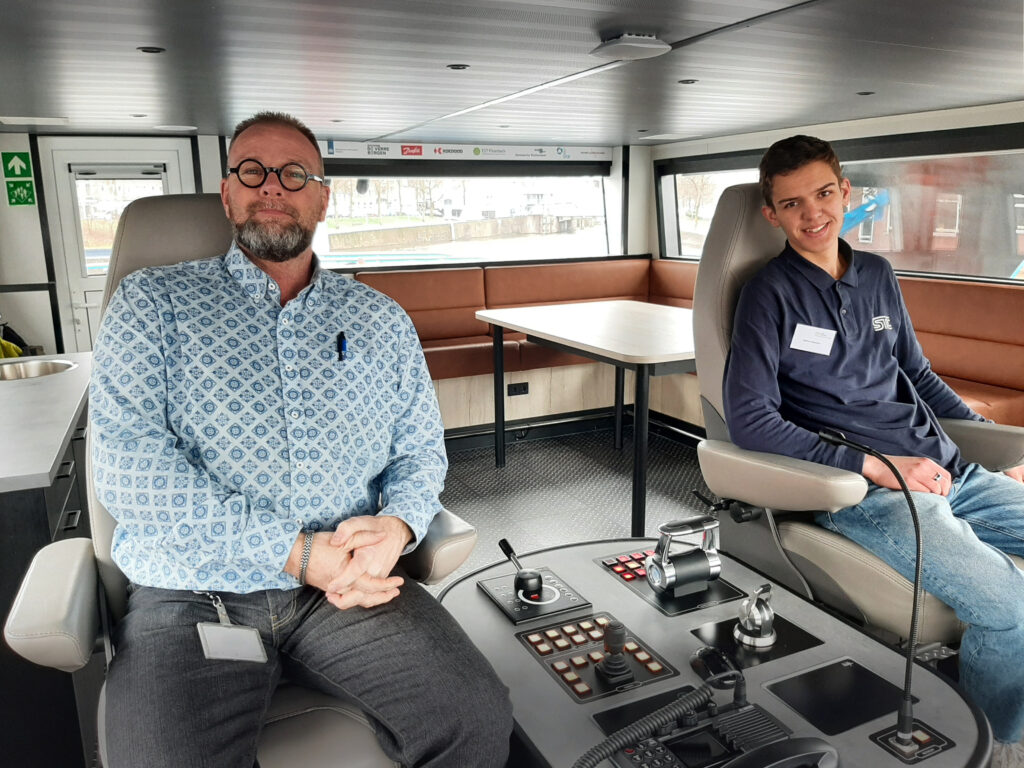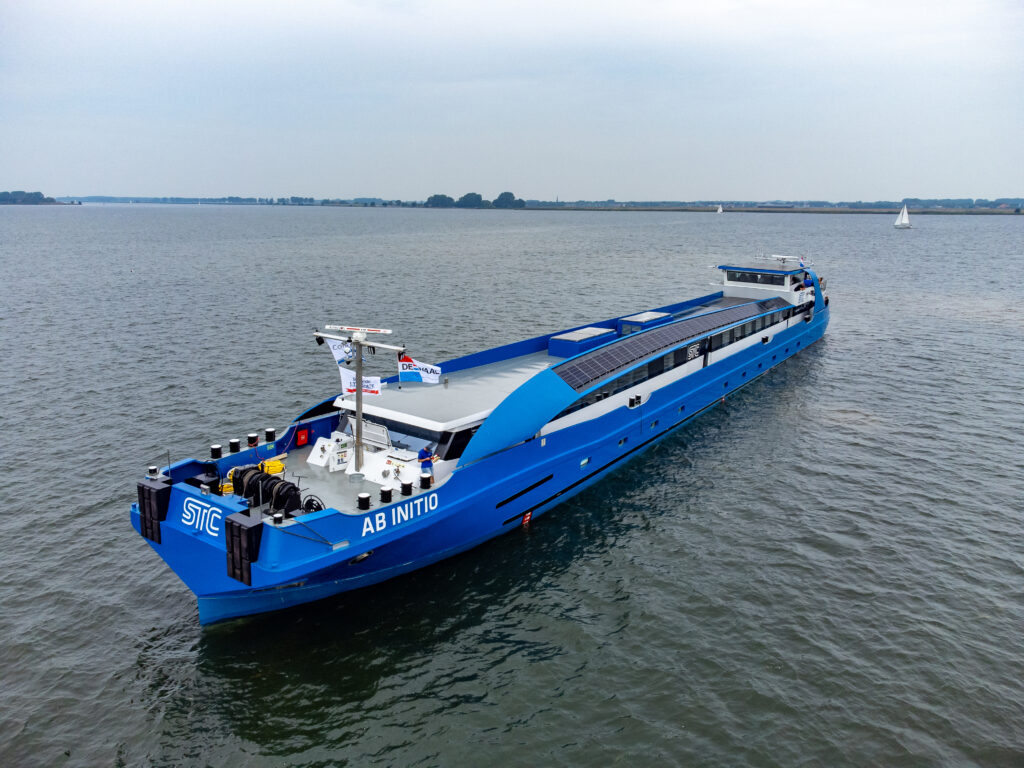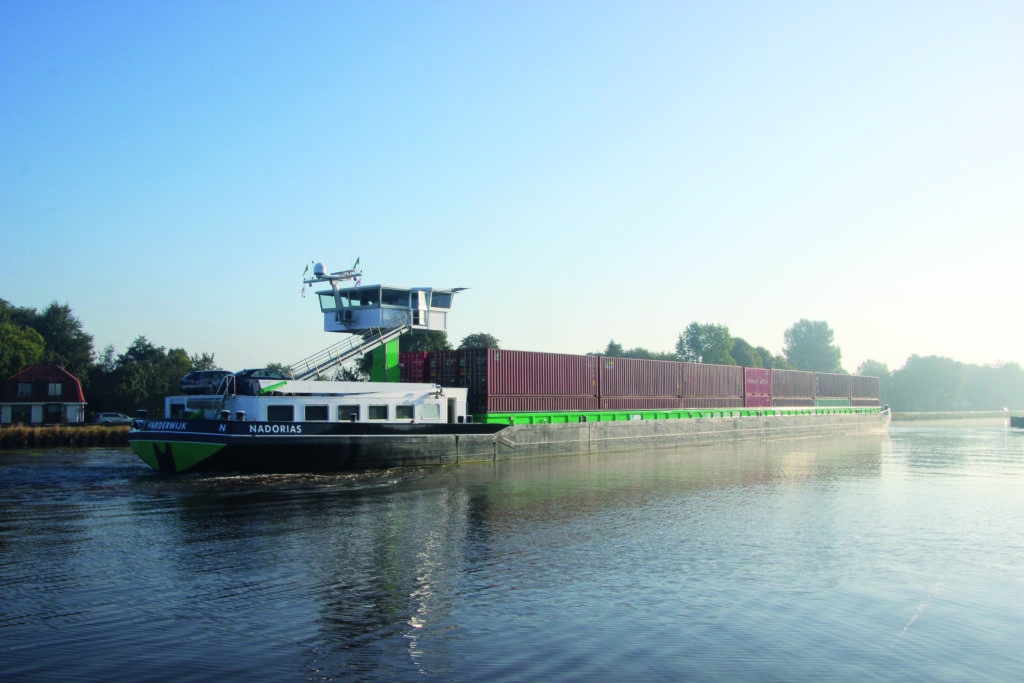On the training vessel Ab Initio you will experience the future of inland shipping
With more than 8,000 inland vessels, the Netherlands has the largest fleet in Europe. Well-trained employees who are familiar with the latest technologies for sustainable inland shipping are the prerequisite for maintaining this top position in the future. The STC Group’s training vessel Ab Initio is stepping up to provide just that. Even now – just a few months after its launch – it is already one of the maritime landmarks in the port of Rotterdam. Come with us on a boat tour! Together with the teachers and students of the training vessel and the experts for sustainable maritime propulsion technology from Oechies Elektrotechniek and Danfoss Drives, you will explore the ship and gain insight into the future of sustainable inland shipping.
Ab Initio: Pioneer for sustainable inland shipping
As a field laboratory and training vessel, the STC Group ‘s Ab Initio has been in service in the port of Rotterdam since the fall of 2022. On the vessel, Richard van der Straaten trains students in various disciplines. Depending on the focus of the maritime training, students on the Ab Initio learn to sail the ship, maintain it or research the latest technologies. The teacher knows why the ship is a prime example of sustainability. Recyclable materials were already used during its construction. They can be replaced and reused at any time. The teacher has an example: "Normally, discarded doors or out-of-fashion wooden panels from the cabins are burned. Metal comes to scrap. This is in need of improvement from an environmental and sustainability perspective. And that’s exactly what we do differently on our ship: The Ab Initio has a modular design. You can think of it as a Lego ship. Wood and metal modules can be removed so that they can be recycled and reused – on other ships, for example, or for bicycles or razor blades."
The ship also impresses in operation with a sustainable propulsion system that can be expanded modularly step by step. In this way, operator STC ensures that the ship will continue to meet all environmental requirements in the future. For this purpose, the training vessel has a diesel-electric hybrid propulsion system. It can even partially generate and use its own energy. The generators are interchangeable, so operators can easily convert the ship to run on fuel cells and hydrogen. "It’s not about switching completely to hydrogen. In one of the next steps, we want to integrate a hydrogen fuel cell into our propulsion system. This way we can then sail emission-free for a few more hours," explains teacher Richard van der Straaten.
Fit for the future: training and learning at Ab Initio

Student William Bezuijen is excited about the opportunity to do his inland waterway captain training on the Ab Initio: "When I signed up for the course, I didn’t even know that the STC was building a new ship. I knew about the two diesel ships, the Princesses Beatrix and Christina. These two ships had been the pride and joy of the STC for a long time.
When I heard that STC was going to replace these ships after 60 years with a brand new ship, I was very curious about what kind of ship that would be. It became a modern diesel-electric ship that can also sail on hydrogen. I have sailed with the Ab Initio 8 or 9 times now, and when you see the development in such a short time, it is unbelievable. It sails so quietly. It’s like a floating hotel where students are taught. On our schedule are day trips and week trips. All with a focus on education. Meanwhile, you can learn about the ship: how to sail, how to secure the ship, and so on. And you can spend the night here, in very nice cabins."
Take the interactive tour: First-hand insights into the sustainable training vessel Ab Initio
Overall, what makes Ab Initio a leader in sustainability? The 67-meter-long, 8.2-meter-wide vessel, with a maximum draft of 1.8 meters, features multiple generators, a lithium-ion battery pack, a 50 kW fuel cell module that can run on hydrogen, 200 m² of solar panels and a wind turbine. It also has a wastewater treatment plant on board. The ship can run emission-free for 4 hours at a time and can carry 39 passengers.
STC Group is a Dutch education and knowledge institution for the shipping, transport and port industry. It is the carrier of the training vessel Ab Initio. STC teacher Richard van der Straaten and student William Bezuijen talk about the purpose and special features of the Ab Initio: take the virtual tour of a special ship with them.
Interactive tech tour for you: What technology drives the Ab Initio?

It is not possible to make a general statement about which propulsion system is the right one for inland vessels. Dick Kant of Danfoss Drives puts it this way: "The propulsion system and the entire electric power system on board depend on a ship’s sailing profile. Fixed route vessels can use replaceable battery packs. Along the route there are charging stations where the ship can replace its battery container. Other types of ships can use clean fuels or hydrogen in combination with a battery pack. You have to look at that carefully on a case-by-case basis."
At Ab Initio, the STC Group decided to combine almost all available technologies in a combined DC bus and AC bus system. Together with Pieter de Vos from system integrator Oechies Elektrotechniek, Danfoss expert Dick Kant was involved in equipping the Ab Initio. Dick Kant speaks of this with enthusiasm: "We have also used the latest development in filter technology from Danfoss: the CMS filter. With it, we can convert DC voltage from the batteries into AC voltage without a transformer. This saves an enormous amount of space and reduces the weight in the ship."
The 770V DC bus of the Ab Initio is equipped with two VACON® NXP Liquid Cooled DC-DC converters. One converts the variable DC voltage coming from the fuel cell into a constant DC voltage. "From the DC bus, we use a VACON® NXP Liquid Cooled microGrid Converter with the CMS filter to generate a main AC bus of 480V/60Hz, to which the frequency converters of the ship’s propulsion are connected. Two smaller grid converters generate a clean voltage of 400V/50Hz to supply the cabins, etc." The second DC-DC converter is used to charge and discharge the battery storage in the ship. You can find a detailed overview of the installed products here.
Did you know that Danfoss can also help you with the development, simulation and validation of your marine projects at the Danfoss Drives Application Development Center in Gorinchem in the Netherlands? We invite you to explore the many ways Danfoss ADC engineers can support you by taking a virtual tour of ADC. "The Danfoss Drive Application Development Center was also involved in the Ab Initio project, as we conducted the verification test for the new CMS filter together with our R&D colleagues in Finland. At the ADC in Gorinchem in the Netherlands, we tested a CMS filter similar to the one used in the Ab Initio," explains Danfoss expert Dick Kant.
Oechies Elektrotechniek took care of the electrical switchboards, the power management system and the control systems of the training vessel. The cooperation between Oechies Elektrotechniek and Danfoss Drives is well-rehearsed and efficient: The two companies have been implementing joint electrification projects for inland shipping for a long time. Learn more about the technical features of the Ab Initio on the virtual technology tour.
What makes inland shipping sustainable?
Conventional ship propulsion systems are controversial: Global shipping accounts for just under 2.5 percent of total greenhouse gas emissions, according to the International Maritime Organization. It causes one billion tons of CO₂ – annually. Residents of port cities such as Rotterdam or Hamburg suffer particularly from this. One solution in inland shipping is ships with electric or hybrid propulsion, such as the Ab Initio.
Meanwhile, the market trend shows an increase in hybrid and electric powered vessels. This has to do with legislation. In the EU, for example, all inland vessels – which include cargo ships, cruise ships and passenger ferries – must be climate-neutral by 2050. And by 2030, the share of electrically powered ships should already be 30%.
"This means that alternative forms of energy such as biofuels, batteries and hydrogen will be needed," says Dick Kant, Business Development Manager at Danfoss Drives. "And that also means building more battery- and fuel cell-powered ships. At the same time, we also see an increase in the number of charging stations on land as these battery containers need to be charged. The advantage of using battery containers is dual: they can be used on shore for grid support and grid stability."
Retrofitting older inland vessels, which still make up the majority of the fleet in the EU, remains a challenge. A successful example is the inland container freighter MS Nadorias. The hybrid retrofit has provided this vessel with fuel savings of 15% and a significant reduction in CO2 emissions. Read the Case Story.

Visit Danfoss Drives at Maritime Industry 2024
Danfoss frequency inverters support all facets of electrical energy conversion in the marine sector. With the help of special software, you can use the same frequency inverter as a so-called DC-DC converter for charging and discharging batteries and for converting a variable battery voltage into a constant DC voltage or vice versa. We would also like to introduce you to our newest family members, the iC7 marine drives. We look forward to demonstrating the possibilities of these intelligent drives to you at Maritime Industry in the Netherlands. Visit us from May 28 to 30 at the Evenementenhal in Gorinchem, stand C.103.
